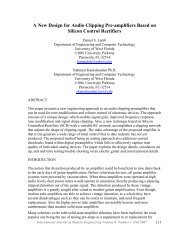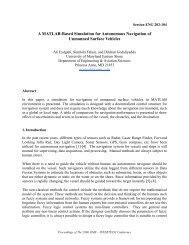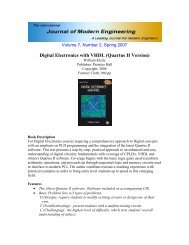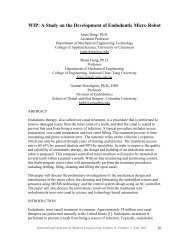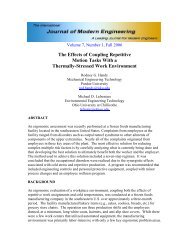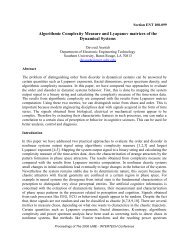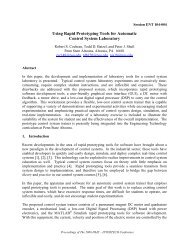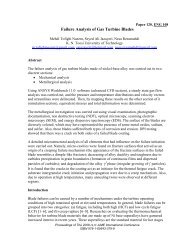Design and Testing of a Permanent Magnet Axial Flux Wind ... - IJME
Design and Testing of a Permanent Magnet Axial Flux Wind ... - IJME
Design and Testing of a Permanent Magnet Axial Flux Wind ... - IJME
You also want an ePaper? Increase the reach of your titles
YUMPU automatically turns print PDFs into web optimized ePapers that Google loves.
is calculated over a range <strong>of</strong> radii (or slices), assuming no radial component <strong>of</strong> magnetic field.<br />
This assumption is reasonable for a non-saturated operation because an ironless stator<br />
machine is not normally operating in a saturated condition. The quasi-3-D approach is<br />
expected to improve accuracy as compared with the mean radius approach—especially in<br />
cases where the relative magnet width varies with the machine radius.<br />
3.1 <strong>Magnet</strong>ic Field Due to <strong>Permanent</strong> <strong>Magnet</strong>s<br />
In this section, an analytic expression for airgap magnetic flux density is determined using<br />
the coordinate system shown in Figure 3, which is a cross-sectional view <strong>of</strong> the machine<br />
looking inward radially. The x <strong>and</strong> y coordinates in Figure 3 represent the circumferential <strong>and</strong><br />
axial directions, respectively. Following the analytical method presented in reference [6],<br />
with appropriate modifications as described previously, the space harmonic (indicated by<br />
subscript n) flux densities at position y due to the magnets on rotors 1 <strong>and</strong> 2 are found to be,<br />
respectively,<br />
where<br />
( unl<br />
m )<br />
( u Y )<br />
Jˆ<br />
n 0 sinh<br />
yn1( x)<br />
cosh n 2<br />
un<br />
sinh<br />
⎟<br />
n 2<br />
⎟<br />
⎛ µ<br />
⎞<br />
= ⎜<br />
⎝<br />
⎠<br />
( u ( Y − y)<br />
) cos(<br />
u x)<br />
B n<br />
( unl<br />
m )<br />
( u Y )<br />
Jˆ<br />
n 0 sinh<br />
2 ( x)<br />
cosh n<br />
un<br />
sinh<br />
⎟<br />
n 2<br />
⎟<br />
⎛ µ<br />
⎞<br />
= ⎜<br />
⎝<br />
⎠<br />
( u ( y)<br />
) cos(<br />
u x)<br />
Byn n<br />
Proceedings <strong>of</strong> The 2008 IAJC-<strong>IJME</strong> International Conference<br />
ISBN 978-1-60643-379-9<br />
(1)<br />
(2)<br />
Y = l + 2l<br />
(3)<br />
2 g m<br />
un m<br />
= 2π n / λ ; λ = 2πR<br />
/ p . (4)<br />
Also, p represents the number <strong>of</strong> pole pairs, Rm is mean core radius for the radial slice under<br />
consideration, <strong>and</strong> J n<br />
ˆ is the equivalent current sheet due to magnets 1 or 2. The total flux<br />
density for each slice <strong>of</strong> the machine is determined by the superposition <strong>of</strong> equation (1) <strong>and</strong><br />
equation (2). The magnets for each radial slice are modeled as an equivalent current sheet:<br />
Jˆ<br />
n<br />
4B<br />
⎛ ⎞<br />
r ⎜<br />
nπτ<br />
m<br />
= sin ⎟<br />
τ ⎜ ⎟<br />
pµ<br />
0µ<br />
rec ⎝<br />
2τ<br />
p ⎠<br />
Figure 3. Model <strong>and</strong> coordinate system for magnetic flux density distribution<br />
(5)



